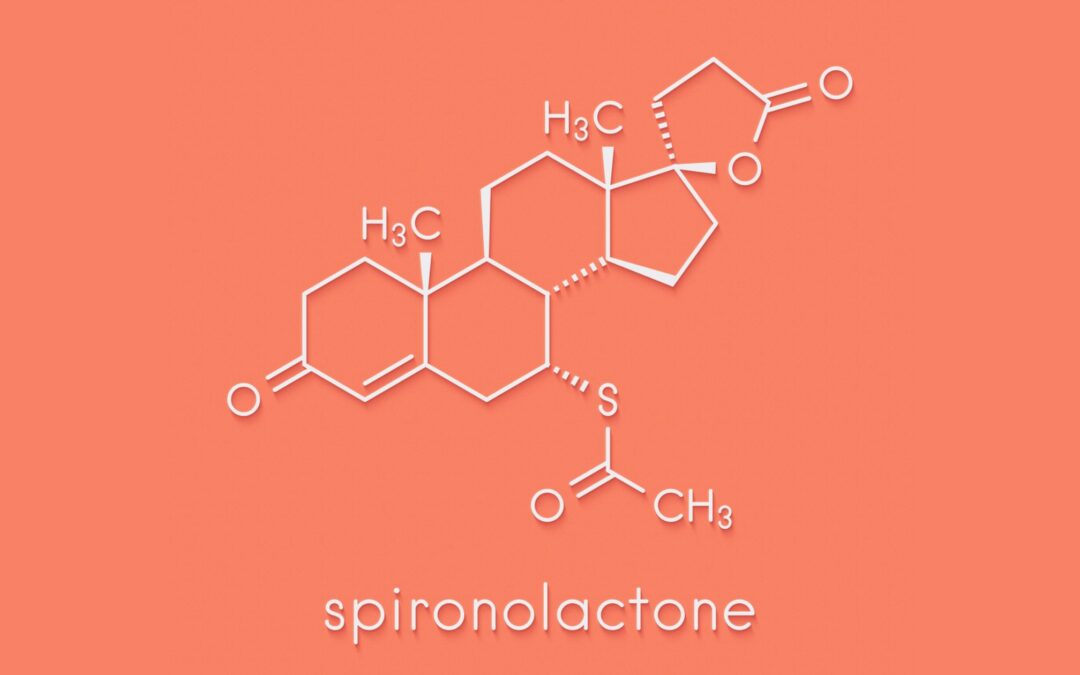Spironolactone as a treatment for hormonal acne
Have you been prescribed spironolactone for female hormonal acne? Want to know more about it? This article will give you a primer of what it is, how it works, and the side effects.
What is spironolactone?
Spironolactone was not developed as an “acne drug”. It belongs to the class of drugs known as potassium-sparing diuretics. Spironolactone is a potent mineral corticoid. Mineral corticoids are steroid hormones that regulate sodium and potassium balance in the body. This, in turn, controls fluid balance. This action helps manage excess fluid retention (oedema) and high blood pressure in chronic heart, liver and kidney disease.
Ok, so how can this work for acne? Well, spironolactone has a secondary action as a moderate antiandrogen. It blocks testosterone receptors, reducing the sebum in the skin. Less sebum can mean fewer breakouts. So, the premise is that if your acne is due to excess androgens and sebum, this drug may help.
Since the 1980s, spironolactone has been increasingly used for female adult acne, PCOS, hair loss and hirsutism. This prescribing is considered “off label” as the drug was not developed or trialled for these uses 1.
In Australia, it is a prescription-only medicine and is part of the Pharmaceutical Benefits Scheme. Common brand names are Aldactone and Spiractin.
Dosages range from 25mg to 200mg a day.
Safety and side effects of spironolactone
The most common side effect of spironolactone is menstrual period irregularities. Midcycle bleeding and amenorrhoea is around 20% at lower doses and 70% at higher doses. When this happens, hormonal birth control is often recommended.
Other common side effects are related to the mineral corticoid action on the hypothalamic-pituitary-adrenal (HPA) axis. These include low blood pressure (dizziness), fatigue, depression and headache and increased urination. No surprises there, as it is a potent diuretic!
Less common side effects include
- Reduced libido due to blockage of testosterone effects
- Breast pain and links to breast cysts
- Weight gain
- Gastrointestinal effects: nausea, vomiting, diarrhoea
Anecdotal reports indicate spironolactone may impact the enzyme diamine oxidase (DAO), which is responsible for breaking down histamine. Hay fever symptoms, allergies and food intolerances could be increased in those who are susceptible.
Hyperkalaemia (high blood potassium) is also something to be aware of. Studies have shown women over 40 years to be at an increased risk for this side effect 2.
How effective is spironolactone for acne?
A 2021 paper notes there is a lack of high-quality evidence (randomised controlled trials) of efficacy. Clinical prescribing is based on primarily expert opinion 3.
Spironolactone is often co-prescribed with hormonal birth control and topical retinoids. Both of these drugs have more robust evidence for their effectiveness. Multiple interventions are used in many of the studies, making it hard to determine the benefits of spironolactone as a stand-alone treatment. A 4-year retrospective study concluded it was only effective when used in combination with other drugs 4.
Research indicates higher doses are more effective (>100mg/day), although this also increases the risk of side effects. Improvements should be seen within 1-3 months1.
What happens when you stop it?
Like with all treatments, if you haven’t corrected the underlying causes, there will likely be a relapse. There is a lack of research regarding the long-term resolution of acne post spironolactone treatment.
Wrapping it up
Although spironolactone is increasingly prescribed for acne, there is limited scientific evidence for its effectiveness as a stand-alone treatment. Higher doses show some benefits but also increase the risk of side effects. There are natural ways to lower androgens, and you can read more about it here.
If you found this interesting, you might also enjoy
Isotretinoin: side effects you need to know about
References:
- Layton AM, Eady EA, Whitehouse H, Del Rosso JQ, Fedorowicz Z, van Zuuren EJ. Oral Spironolactone for Acne Vulgaris in Adult Females: A Hybrid Systematic Review. Am J Clin Dermatol. 2017;18(2):169-191. doi:10.1007/s40257-016-0245-x
- Thiede RM, Rastogi S, Nardone B, et al. Hyperkalemia in women with acne exposed to oral spironolactone: A retrospective study from the RADAR (Research on Adverse Drug Events and Reports) program. Int J Women’s Dermatology. 2019;5(3):155-157. doi:10.1016/j.ijwd.2019.04.024
- Han JJ, Faletsky A, Barbieri JS, Mostaghimi A. New Acne Therapies and Updates on Use of Spironolactone and Isotretinoin: A Narrative Review. Dermatol Ther (Heidelb). 2021;11(1):79-91. doi:10.1007/s13555-020-00481-w
- Grandhi R, Alikhan A. Spironolactone for the Treatment of Acne: A 4-Year Retrospective Study. Dermatology. 2017;233(2-3):141-144. doi:10.1159/000471799

Need help with your acne?
Norelle Hentschel is an experienced Naturopath with a clinic in Stones Corner, South East Brisbane and also offers Telehealth consults Australia wide. She enjoys supporting her clients on their clear skin journey.
Want more articles like this?
Join us at Your Skin Remedy – the monthly missive for healthy skin from the inside out. Practical, actionable, and informative. Your clear, glowing skin starts here.
PS. Your inbox real estate is precious. Your Skin Remedy is pitch and promo free. I promise. One email a month — that’s it.

